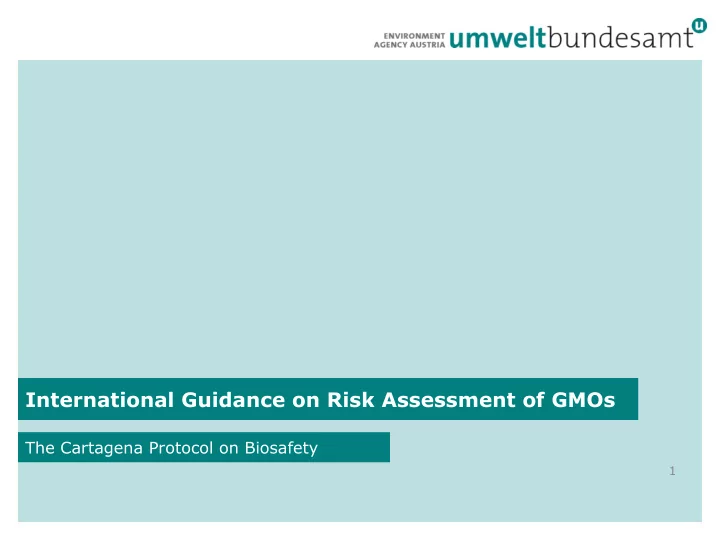

International Guidance on Risk Assessment of GMOs The Cartagena Protocol on Biosafety 1
Introduction of the Speaker n Dr. Helmut Gaugitsch n Environment Agency Austria, Head of Unit Landuse & Biosafety n Biotechnologist and molecular biologist by training, dealing with environmental effects of land use activities including risk assessment and monitoring of GMOs/LMOs n Former chair of the OECD Working Group on Harmonization of regulatory oversight in biotechnology, as well as the UN ECE Aarhus Convention Working Group on GMOs n Currently Chair of the Cartagena Protocol AHTEG on Risk assessment and risk management 2
Topics n The Cartagena Protocol Draft Guidance on Risk Assessment of LMOs n AHTEG: the Process n Current stage of the Work n The way forward 3
Cartagena Protocol - Background n Risk Assessment is a corner stone in decision making n Transboundary movement and import n Intentional release – field trial, commercialisation of an LMO product n COPMOP Decisions on Risk Assessment and Risk Management n Ad Hoc Technical Expert Groups 4
Cartagena Protocol – AHTEG on Risk Assessment and Risk Management n COPMOP-4, Bonn, May 2008 n Establishment of an Ad Hoc Technical Expert Group on Risk Assessment – Mandate, 28 members n Development of a „Road Map “ on Risk Assessment n Further Guidance on Specific aspects of risk assessment n Recommendation to COPMOP-5, Nagoya, October 2010 n Extend the current open-ended online forum and the AHTEG 5
AHTEG – Current Mandate n Work primarily online to revise and test the version of the Guidance on the basis of a scientific review process n Assess the overall utility of the Guidance to LMOs across different taxa and receiving environments n Expected outcomes: n Revised version of the Guidance on Risk Assessment of LMOs n Mechanism for update of background materials n Further Guidance on new specific topics of risk assessment 6
Guidance on Risk Assessment of LMOs n Part I: Roadmap for Risk Assessment of LMOs n Part II: Specific Types of LMOs and Traits n LM plants with stacked genes or traits n LM plants with tolerance to abiotic stress n LM Mosquitoes n Further Guidance (since AHTEG – 3): n LM Trees n Monitoring of LMOs released into the environment 7
The Roadmap What is the roadmap for LMO Risk Assessment? n Build on and complement Annex III n Further guidance on how to undertake an LMO risk assessment n All types of LMOs n All types of applications (field trials, commercial products) n Overarching issues such as consideration of uncertainty n Planning Phase of the risk assessment n Conducting the risk assessment (5 Steps) n Flowchart (Visualisation of the Roadmap) 8
Planning Phase of the Risk Assessment Setting the context and scope: may involve a process that includes risk assessors, decision makers and various stakeholders n Existing policies and strategies (e.g. protection goals, assessment endpoints, risk thresholds and management strategies) n Nature and level of detail of information n Methodological and analytical requirements n Experience and history of use of non-modified recipient n The choice of comparators 9
Conducting the Risk assessment n Step 1: Identification of potential adverse effects n Step 2: Evaluation of the likelihood n Step 3: Evaluation of the consequences n Step 4: Estimation of the overall risk n Step 5: Recommendation whether risks acceptable or manageable, any risk management strategies 10
Detailed contents of Roadmap For each step: n Rationale n Points to consider n Links to background material 11
Step 1 n Identification of any novel genotypic and phenotypic characteristics that may have adverse effects n Rationale: identify biological changes resulting from the genetic modification – „hazard identification “ , comparison with non-LMO n Points to consider ( examples ): n Characteristics of the recipient n Molecular characteristics of the LMO n Genotypic or phenotypic changes n Receiving environment n Interaction LMO/environment (e.g. outcrossing, uncertainty) 12
Step 2 n Evaluation of the likelihood of adverse effects n Rationale: whether the environment will be exposed, potential of the LMO to spread or establish, possibility of adverse effects to occur (tox, allergenicity, non-target effects) n Points to consider: n Type and intended use of the LMO n Levels of expression n Receiving environment n Outcrossing n Expected exposure 13
Step 3 n Evaluation of the Consequences n Rationale: magnitude of the consequences in the environment, test results, comparative evaluation (non- modified organism, existing practice) n Points to consider: n Experience with consequences of existing practice n Combinatorial and cumulative effects in the environment n Results from the lab n Expression of the transgene in sexually compatible species 14
Step 4 n Estimation of the overall risk n Rationale: based on steps 1, as well as 2 and 3. n Points to consider: n Steps 1 to 3 n Interaction between individual risks n Consideration of uncertainty arising in this and the previous steps 15
Step 5 n Recommendation whether risks are acceptable or manageable, strategies to manage risks? n Rationale: interface risk assessment/risk management. Risks not acceptable or manageable – risk management? Iterative process with risk assessment. n Points to consider: n Existing management practices (e.g. isolation distances) n Methods to detect and identify LMOs n Management options? n Criteria and thresholds for acceptable/unacceptable risk n Baseline for comparison 16
Additional Guidance n Risk Assessment of LM Trees n Monitoring of LMOs released into the environment (heavily discussed!) – Case specific monitoring, General Surveillance 17
Next steps n Further development of the Guidance n AHTEG -4 in June 2012: Finalization of tasks n Report and Decision at COPMOP-6, India, October 2012 18
Further information on Cartagena Protocol and AHTEG n http://bch.cbd.int/protocol/ n Biosafety Clearing House: http://bch.cbd.int/ 19
GMOs in other international instruments n WTO: SPS, TBT n Codex Alimentarius (Food) n Interntaional Plant Protection Convention (IPPC) n OIE (animals) n OECD n Aarhus Convention 20
Contact & Information Helmut Gaugitsch +43-1-31304-3133 helmut.gaugitsch@umweltbundesamt.at Umweltbundesamt GMSAFOOD Conference, Vienna, www.umweltbundesamt.at Austria, March 2012 21
Recommend
More recommend